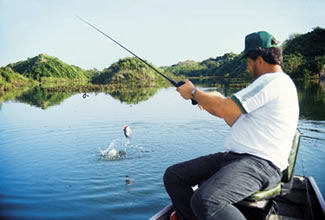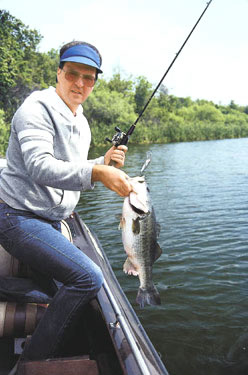May 08, 2015
By Larry Larsen
Tactics for catching bass in Florida's phosphate lakes.

Bottom contour is reflected in the bumpy hills on shore. Bass relate to this kind of deep structure on phosphate pit lakes. |
Phosphate pits are unique in Florida for their underwater terrain. Unlike our natural lakes, which are mostly shallow bowls, the dug pits contain humps, deep holes and even hilltops projecting above the submerged landscape. The broad, grassy shorelines of natural lakes are absent. Many have sharp dropoffs near some banks and some of the better ones even have a profuse growth of hydrilla. For those reasons, tactics for successful bass fishing may vary.
Some 90 percent of the U.S. phosphate waters lie within 50 miles of our I-4 corridor in Polk, Hillsborough, Manatee, Hardee and DeSoto counties and, to a lesser extent, in North Florida, so they are handy to a lot of anglers. And some of the pits offer public access—and great fishing thanks to tight regulations. Tenoroc Preserve, off S.R. 33 northeast of Lakeland, and Medard Park, off Turkey Creek Road southeast of Brandon, are two excellent examples of quality public-access pits. The hundreds of private pits in the area are even better. In fact, phosphate pit bass fishing is twice as productive as that found in the state's numerous natural waters, according to surveys by state biologists.
The formation of the miniature bass waters occurred, for the most part, 20 to 40 years ago as phosphate rock deposits were unearthed. Variations of structure and depth changes are created as the massive dragline buckets dig through the sandy soil to get at the raw phosphate rock beneath. The depth of the pits varies from site to site, but many run 40 feet or more. A majority of the un-reclaimed waters have islands separating rows of channels averaging 15 feet in depth. The channels are deeper than those in our state's natural waters and provide pit bass the opportunity to migrate to and from deeper water. The high nutrient content of the water results in rapid growth of shad, which in turn creates lots of big, fat bass.
But where are these bass? Usually not on the shoreline as in natural lakes. Most quality largemouth in the pits hang out offshore on humps, submerged islands or ditches. Large concentrations of bass can often be found on such topo changes.
Finding humps is difficult when you visit a phosphate pit for the first time. Best bet is to make a rapid tour, watch the depthfinder, and note where the abrupt rises and drops occur—a GPS is the easy way, or you can drop marker floats. If you have no electronics, trolling with a crankbait that gets down to 15 feet or more can do the job.
In deep water, vertical jigging or pitching may be most productive. Match lure choice to the depth. Weighted spinnerbaits are effective down to about 12 feet, crankbaits down to 16 and worms and jigging spoons down to about 25. Heavy jigs and jigging spoons can be effective even deeper if you can find such depths (and they do exist in the state's phosphate pits). Shallow-running lures and topwater fare usually are not productive over deep waters, unless bass are schooling and aggressively chasing shad.

Deep-diving crankbaits often pick up bites on these unusually deep Florida lakes. |
Whatever the lure, use a sonar unit to define the hump dropoff, and position the boat over the top of the break. Then, with worm, jig or spoon, make a 20- to 30-foot pitch in front of the boat and peel line so that the bait falls straight to the bottom. Snap the lure off the bottom, then “feel” it back to bottom. Most bass will hit on the fall, so be alert for any tick on the line. A few might stop the lure as you snap it upward.
To fish a hump or other bottom feature from a distance, employ marker buoys. Drop a couple around the top of the hump to outline it for a visual reference. Such definition is vital to precise boat positioning away from the structure, and to accurate casting and lure presentations. Mark the spot while carefully inspecting any contours with structure showing up on the sonar screen. It may reveal subtle bends, dropoffs and structure in the form of rocks, vegetation or timber on the bottom, or perhaps fish.
Choose a crankbait that will dive and make contact with the bottom structure; some are designed to go no deeper than 8 feet, some 12, some 15, so select one that is adequate—you'll know when you feel it bumping across bottom. Often, an instant after it hits bottom, you'll feel a bass slam it—the bottom contact seems to turn fish on. Crawling a worm down the incline can also be deadly.
FS
